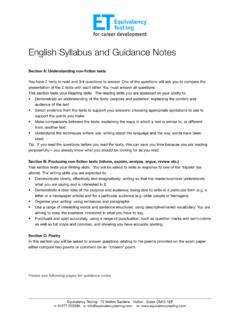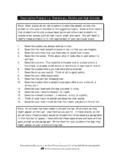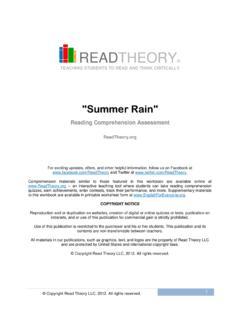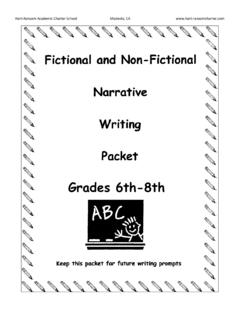Transcription of Literacy & Numeracy Handbook 2015 - Xavier …
1 Xavier Catholic College Literacy & Numeracy Handbook 2015 Version: 11/12/2014 Contents GENERAL TIPS Page No. Introduction the purpose of this book 1 The writing process: What do I need to do? 2 The Information Literacy Process 3 What is Plagiarism 4 How to avoid plagiarism 5 Grammar Tips 6 Punctuation Tips 7 Learn to spell 8 English versus American spelling 9 Frequently misspelt words 10 Frequently misspelled words for older students 11 Glossary of key words 12 Modality 13 Persuasive and emotive language 14 Vocabulary to improve extended responses 15 Peel paragraphs 16 Language Devices 17 Connective Words 18 How to write to paragraph 19 Example of a paragraph plan 20 Assignment Tips 21 Assignment Writing Checklist 22 Oral Presentations 23 Digital Slide Presentations 24 Reading Skills 25 Scanning 26
2 Note Taking 27 Tips to effective internet searching 32 Numeracy Numeracy Tips 34 Essential Mathematics Concepts 36 Mathematics Glossary 41 Fraction Strips 49 Tips for using the calculator 50 TAS (Technical & Applied Science) Design Process 52 NARRATIVE Narrative 54 Example of a Narrative 55 Narrative template 56 RECOUNT Recount 57 Example of a Recount 58 Recount template 59 PROCEDURE Procedure 60 Example of Procedural text 61 Procedural template 62 INFORMATION REPORT Information Report 63 Example of Information Report 64 Information Report template 65 Biography template 66 Newspaper report 67 Example of newspaper report 68 Newspaper report template 69 Scientific report template experiment report format 70 Science report template 72 How to write a review 73 Book review scaffold 74 Film review scaffold 75 EXPLANATION
3 Explanation 77 Features of an explanation 78 Explanation template 79 EXPOSITIONS Expositions present one side of an argument 80 Example of an exposition 81 Exposition essay planner 82 PERSUASION Persuasion 83 Persuasive text Example 1 84 Persuasion map 85 Persuasion map example 86 Persuasion template 87 Persuasive letter template 88 REFERENCING Referencing 91 How should I set out my bibliography? 93 Example of a bibliography 95 Acknowledgements 96 Page | 1 INTRODUCTION This Literacy and Numeracy Handbook has been designed to give students, parents and teachers practical support with Literacy and Numeracy of all kinds across different subject areas.
4 The purpose of the Handbook is to improve the quality of written and numerical work produced at Xavier Catholic College by providing clear guidelines and relevant information. The first part of the Handbook contains general writing tips how to plan, draft, proofread, edit writing - to improve the clarity, cohesion and sophistication of text composition. The second part contains general Numeracy information. The final part of the Handbook provides explanations, examples, planning sheets and writing scaffolds for a range of text-types that are used across Key Learning Areas.
5 Through providing explicit modeling and appropriate resources, the goal is to create a shared understanding of excellence in writing that will be evident in improved student outcomes. TYPES OF ASSIGNMENTS AND HOW TO PREPARE THEM In every subject that you do in high school you will be asked to communicate facts, interpretations and analysis in written form. A variety of formats, text types or genres will be required depending on the type of information you will be presenting. In this section we have set out some of the most commonly used text types for Year 7 to 10, including narrative, information report, science report, procedure, persuasive text, discussion and essay.
6 We have also suggested when it is appropriate to use each type. If you are unsure at all about what text type you should be using, remember to ask your teacher. Page | 2 Decide on: a topic audience Prewriting a) Make sure you understand the purpose of the task. b) Brainstorm what you know and what you need to know. c) Gather information you need. Keep a record of the references you have used as you go. d) Plan your ideas, layout and structure e) Take notes by using mind map or a graphic organiser Drafting a) Decide on a writing template that you will use. b) Follow the structure of the template. c) Write down your ideas in note form (if you wish you could use a template or a graphic organiser).
7 D) Transfer your notes into sentences. e) If you are constructing paragraphs make sure you have followed the structure of a paragraph. For example, do you need a topic sentence? Editing and proofreading your work a) Read your writing. Does it make sense? b) Have you used specific words to support your ideas? c) Have you asked someone else to check your work? d) Or have you shown your teacher? e) Do you need to add more? f) Have you written it for your chosen audience? g) Have you checked for mistakes, such as punctuation, spelling and grammar? h) Have you followed the structure of that particular text type?
8 I) Are you ready to write your final copy? j) Have you used the correct tense ( past, present or future) throughout your writing ? Publishing a) Write your final/good copy b) Is this your best work? c) Is it presented well? d) Have you included references/glossary and diagrams? (Where applicable) P a g e | 3 THE INFORMATION Literacy PROCESS Defining What is the problem I have to solve? What are the main ideas? What information do I need? What do I already know? What more do I need to find out? How can I use focus questions to help me organise the task? What are the keywords that will help me? Locating Where can I find the information I need?
9 Which sources best meet my needs? Which sources do I already have? Where can I find those resources I don't have? Do I need help to find the resources? Do I need help to access or use these resources? Selecting How can I search these sources effectively? Are there any clues and cues to help me? Which main ideas am I looking for? Which search terms will help me find these? How will I know that the information is recent, relevant, accurate and unbiased? How will I record the information I find? How will I credit my sources? Organising How can I organise this information so that I can understand it better? Does it need to be in a special order?
10 How can I arrange it so that it is easily understood by others? Have I solved the problem? Have I answered my focus questions? Do I need more information? Presenting How can I share this information with other people? Who will be my audience? What is the purpose of the presentation? Which would be the best format to meet these needs? What do I need to do with this presentation? Have I included everything I want to share? Assessing What have I learned from this? Did I answer my focus questions? Did I use the rubric to ensure I did all the things I needed to do? Did I manage my time well? How have my skills improved?







